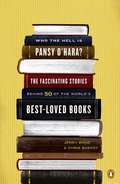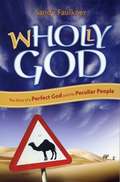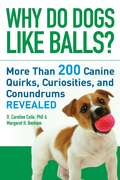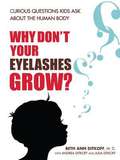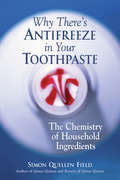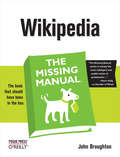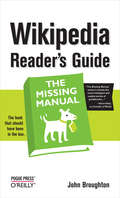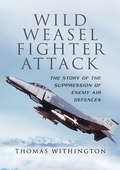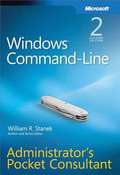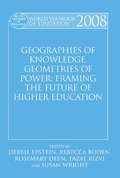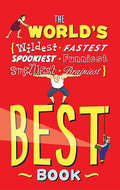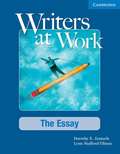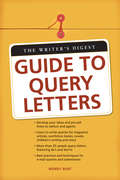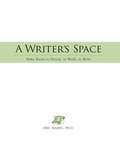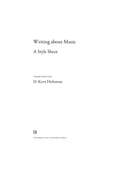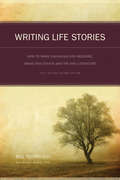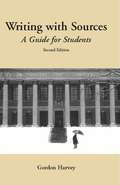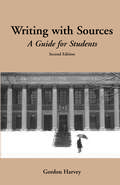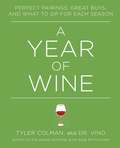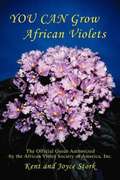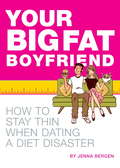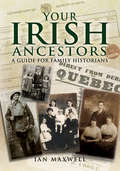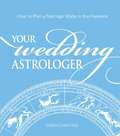- Table View
- List View
Who the Hell is Pansy O'Hara?: The Fascinating Stories Behind 50 of the World's Best-Loved Books
by Jenny Bond Chris SheedyThe captivating stories behind fifty of the greatest authors and their most famous literary creations Before Who the Hell is Pansy O'Hara ?, there had never been a single volume that explored the backstories of so many of the greatest books in the English language. A work sure to captivate all lovers of language and literature, it reveals in short, pithy chapters, the lives, loves, motivations, and quirky, fascinating details involving fifty of the best-loved books of the Western world. When stacked up, the original manuscript of Gone With the Wind stood taller than Margaret Mitchell, its 4' 9 1/2" author Ian Fleming, creator of James Bond, was part of the Allied team that cracked the Nazi's Enigma code. Leo Tolstoy's wife copied War and Peace by hand . . . seven times. From The Great Gatsby to Harper Lee, from Jaws to J. K . Rowling, Who the Hell Is Pansy O'Hara? offers an entertaining and informative journey through the minds of writers and the life experiences that took these amazing works from notion to novel. .
Wholly God: The Story of a Perfect God and his Peculiar People
by Sandy FaulknerFor twenty years Sandy Faulkner has walked with her students through the Red Sea, up Mt. Sinai, into the wilderness and around the walls of Jericho. With the passion of a teacher, the humor of a master storyteller and the authenticity of a sojourner, Sandy tells the Old Testament story without sugar coating but with love for the characters--even the bad ones--and devotion to the main character of the story, the LORD, who is not only holy but wholly God. Wholly God is designed for two groups of people: those who do not yet know the story and are just beginning the journey and believers who need a fuller, better understanding of the whole story--who may know the stories but do not see how the stories form The Story.
Why Do Dogs Like Balls?: More Than 200 Canine Quirks, Curiosities, and Conundrums Revealed
by D. Caroline Coile Margaret H. BonhamDo dogs believe pictures of dogs are real? Why do dogs turn in a circle before they lie down? Can you trust someone your dog hates? Dog owners have questions; here are the answers to more than 200 of them, provided by two of the most knowledgeable writers in the field. Fun to read, eye-opening, and filled with important facts that every fan of Fido should know, it encompasses topics ranging from doggie intelligence (Can dogs learn to read?) to canine behavior, body, and senses (Can a dog sniff out cancer?). Find out if blind dogs are sad, whether dogs should be allowed to roam, why they lick you, and why they wag their tails. You'll gain a better, deeper understanding of your best friend.
Why Don't Your Eyelashes Grow?
by Beth Ann DitkoffRead Beth Ann Ditkoff's posts on the Penguin Blog. Ever wondered what that small dewdrop thing is in the back of your throat? Or why you hiccup? Why Don't Your Eyelashes Grow? addresses every weird question about your body that you could think of--or didn't even think to ask. Prompted by the brain stumpers her own children and patients have asked her over the years, Dr. Beth Ann Ditkoff compiled a list of curious medical questions. In this book, she reveals the mysteries of the human body (gross, funny, or ugly!) to children and adults. With eye-opening questions, like "Why do toenails grow slower than fingernails?" and "Why do you have earwax?" to weird oddities, like "Why do some people have dimples?" and "Why do you get a headache when you eat ice cream too quickly?" Ditkoff also explains hilarious and bizarre anatomy "situations" that every curious kid wonders, from "If you put a pea up your nose, will it go into your brain?" to "If you eat Pop Rocks candy and drink soda at the same time, will your stomach explode?" With expert explanations throughout, Why Don't Your Eyelashes Grow? is an entertaining potpourri of fun factoids packed with real information.
Why There's Antifreeze in Your Toothpaste: The Chemistry of Household Ingredients
by Simon Quellen FieldA Selection of the Scientific American Book ClubExplaining why antifreeze is a component of toothpaste and how salt works in shampoo, this fascinating handbook delves into the chemistry of everyday household products. Decoding more than 150 cryptic ingredients, the guide explains each component's structural formula, offers synonymous names, and describes its common uses. This informative resource can serve curious readers as a basic primer to commercial chemistry or as an indexed reference for specific compounds found on a product label. Grouped according to type, these chemical descriptions will dissolve common misunderstandings and help make consumers more product savvy.
Wikipedia: The Missing Manual
by John BroughtonWant to be part of the largest group-writing project in human history? Learn how to contribute to Wikipedia, the user-generated online reference for the 21st century. Considered more popular than eBay, Microsoft.com, and Amazon.com, Wikipedia servers respond to approximately 30,000 requests per second, or about 2.5 billion per day. It's become the first point of reference for people the world over who need a fact fast. If you want to jump on board and add to the content, Wikipedia: The Missing Manual is your first-class ticket. Wikipedia has more than 9 million entries in 250 languages, over 2 million articles in the English language alone. Each one is written and edited by an ever-changing cast of volunteer editors. You can be one of them. With the tips in this book, you'll quickly learn how to get more out of -- and put more into -- this valuable online resource.Wikipedia: The Missing Manual gives you practical advice on creating articles and collaborating with fellow editors, improving existing articles, and working with the Wikipedia community to review new articles, mediate disputes, and maintain the site. Up to the challenge? This one-of-a-kind book includes: Basic editing techniques, including the right and wrong ways to edit Pinpoint advice about which types of articles do and do not belong on Wikipedia Ways to learn from other editors and communicate with them via the site's talk pages Tricks for using templates and timesaving automated editing tools Recommended procedures for fighting spam and vandalism Guidance on adding citations, links, and images to your articles Wikipedia depends on people just like you to help the site grow and maintain the highest quality. With Wikipedia: The Missing Manual, you get all the tools you need to be part of the crew.
Wikipedia Reader's Guide: The Missing Manual
by John BroughtonYou don't have to understand how to edit Wikipedia in order to find the information you need and join the conversation. This booklet gives you just what you need to know in friendly, concise form so you can research any subject without getting lost in Wikipedia's labyrinth. With it, you'll be able to unlock the mysteries of the many links on every Wikipedia page and the sometimes cryptic buzzwords you see on Talk pages. And, while this booklet focuses on Wikipedia readers, it also includes a tutorial for first-time editors and explains Wikipedia's editing tools. You'll find valuable advice on how to alert editors to flaws in articles and how to contribute to Talk pages without getting caught up in pointless disputes. The author of Wikipedia Reader's Guide: The Missing Manual has edited more than 15,000 Wikipedia articles, and has written a comprehensive index to Wikipedia for editors to use in their daily work. His knowledge of Wikipedia is limitless and his passion is contagious. With this guide, you'll catch on quickly.
Wild Weasel Fighter Attack: The Story of the Suppression of Enemy Air Defences
by Thomas WithingtonDetecting and destroying enemy Surface-to-Air Missiles (S.A.M.) and radar is arguably the most dangerous mission that any pilot can undertake. Tactics differ with air forces, but the general principal is to fly a formation of aircraft into an area where the enemys air defenses are strong, wait for their radar to illuminate the aircraft and then launch a volley of anti-radiation missiles to destroy the radar and thus blind the S.A.M. and air defenses. Put simply, without the Suppression of Enemy Air Defences (S.E.A.D.) mission, the loss of other aircraft will be too high and the effectiveness of attack on the enemy too low.Despite the undeniable bravery of the aircrews who flew these missions for the United States Air Force in every conflict since the Vietnam war, and their colleagues in other air forces across the world who have risked their lives in similar missions, the tactics, history, aircraft and weapons of the S.E.A.D. mission have seldom benefited from rigorous historical examination. Using interviews with S.E.A.D. pilots, industrial experts and historical documents this book for the first time will give a detailed history of the S.E.A.D. mission from the Vietnam War to the present day.
Windows® Command-Line Administrators Pocket Consultant
by William R. StanekNow updated for Windows Server® 2008 and Windows Vista®, this practical, pocket-sized reference delivers ready answers for using Windows command-line tools to manage multiple clients and servers. It's packed with hundreds of examples that show you how to run, use, schedule, and script Windows commands, support tools, and Resource Kit tools--without touching the GUI. Written by a well-known author of more than two dozen computer books--and featuring easy-to-read tables, lists, and step-by step instructions--this POCKET CONSULTANT delivers fast, accurate information on the spot.
World Yearbook of Education 2008: Geographies of Knowledge, Geometries of Power: Framing the Future of Higher Education (World Yearbook of Education #Vol. 2008)
by Debbie Epstein Rebecca Boden Rosemary Deem Fazal Rizvi Susan WrightThis volume examines higher education in globalized conditions through a focus on the spatial, historic and economic relations of power in which it is embedded. Distinct geometries of power are emerging as the knowledge production capability of universities is increasingly globalized. Changes in the organization and practices of higher education tend to travel from the ‘West to the rest’. Thus, distinctive geographies of knowledge are being produced, intersected by geometries of power and raising questions about the recognition, production, control and usage of university-produced knowledge in different regions of the world. What flows of power and influence can be traced in the shifting geographies of higher education? How do national systems locate themselves in global arenas, and what consequences does such positioning have for local practices and relations of higher education? How do universities and university workers respond to the increasing commodification of knowledge? How do consumers of knowledge assess the quality of the ‘goods’ on offer in a global marketplace? The 2008 volume of the World yearbook addresses these questions, highlighting four key areas: Producing and Reproducing the University— How is the university adapting to the pressures of globalization? Supplying Knowledge—What structural and cultural changes are demanded from the university in its new role as a free market supplier of knowledge? Demanding Knowledge—Marketing and Consumption—How can consumers best assess the quality of education on a global scale? Transnational Academic Flows—What trends are evident in the flow of students, knowledge and capital, with what consequences? The 2008 volume is interdisciplinary in its approach, drawing on scholarship from accounting, finance and human geography as well as from the field of education. Transnational influences examined include UNESCO and OECD, GATS and the effects of digital technologies. Contrasting contexts include Central and Eastern Europe, Finland, China and India and England. With its emphasis on the interrelationship of knowledge and power, and its attention to emergent spatial inequalities, Geographies of Knowledge, Geometries of Power: Framing the Future of Higher Education provides a rich and compelling resource for understanding emergent practices and relations of knowledge production and exchange in global higher education.
The World's Best Book: The Spookiest, Smelliest, Wildest, Oldest, Weirdest, Brainiest, and Funniest Facts
by Jan PayneWith all of the books in the world, this one is the best! With a multitude of did-you-knows, accompanied by hilarious illustrations, page after page is packed with the best entertainment and education. For kids craving to jam their brains with odd and intriguing facts, here's a banquet-stuffed with the fastest, brightest, longest, funniest, weirdest, wildest, wettest, smelliest, brainiest, and fascinating-est things in the world!
Writers at Work: The Essay
by Dorothy E. Zemach Lynn Stafford-YilmazThe Writers at Work series takes beginning to high intermediate-level writing students through a process approach to writing. The series is intended primarily for adults whose first language is not English, but it may also prove effective for younger writers or for native speakers of English who are developing their competence as independent writers in English.
The Writer's Digest: Guide to Query Letters
by Wendy Burt-ThomasMake That Crucial, Positive First Impression Anyone who's researched the marketplace knows: The path to publication begins with your query letter. If your query is weak, unfocused, or uninspired, an editor or agent won't even bother to request your article, novel manuscript, or nonfiction book proposal. But a well-crafted, compelling query sent to the right editor or agent is an essential sales tool for fiction writers and the most effective way for nonfiction writers to pre-sell your idea. In this book, professional freelance writer and magazine editor Wendy Burt-Thomas shares practical advice on how to craft persuasive letters that connect with editors and agents and ultimately generate sales for you. You'll learn how to: Conduct targeted research to find suitable editors and agents Hook an editor with a tantalizing lead and shape a summary that compels editors to buy Select the strongest slant for your book or article Use research and interview shortcuts that keep your query prep profitable Make your query rejection-proof by weeding out subtle mistakes that can sabotage your project Communicate your author platform and sell yourself as the best writer for the subject Complete with dozens of sample queries–some that landed article assignments, agents, or book deals, and others that never stood a chance–this book offers you a comprehensive strategy for presenting your writing ideas in a way that will increase your chances of publication. Though the title may lead some to believe it's strictly to be shelved as a reference manual,The Writer's Digest Guide to Query Lettersis a smooth read from cover to cover.
A Writer's Space
by Eric MaiselTo write what you want to write, the way you want to write it, you need to create both psychic and physical space. In A Writer's Space, noted creativity expert and bestselling author Dr. Eric Maisel shows you how to do just that. He takes you by the hand and guides you deep into your own creative process, helping you to: Honor your inner muse; Spark your creative impulse; Make the most of time you spend writing; Devise personalized rituals to start you writing and keep you writing; Create a work space that complements the writing process; Design a writing schedule that's easy to follow, no matter what. Calling upon his own writing experience, as well as his extensive knowledge of the creative process, Dr. Maisel will help you define the physical and mental space you need to produce the best work you've ever created, page after page!
A Writer's Space: Make room to dream, to work, to write
by Eric MaiselA Simon & Schuster eBook. Simon & Schuster has a great book for every reader.
A Writer's Space
by Eric MaiselA guide for writers to help them delve deep into their creative process.
Writing about Music
by D. Kern HolomanHow do you spell "Mendelssohn"? Where do you place the hyphen in "Beethoven" if it breaks between two lines? Is it "premiere" or "première"? The answers and much more can be found in this completely revised and updated resource for authors, students, editors, concert producers--anyone who deals with classical music in print. This essential volume covers some of the thorniest issues of musical discourse: how to go about describing musical works and procedures in prose, the rules for citations in notes and bibliography, and proper preparation of such materials as musical examples, tables, and illustrations. One section discusses program notes, another explains the requirements for submitting manuscripts and electronic files. A new section outlines best practices for student writers. An appendix lists common problem words.
Writing Life Stories: How to Make Memories into Memoirs, Ideas into Essays, and Life into Literature - Fully Revised Second Edition
by Bill Roorbach Kristen KecklerHow to Make Memories into Memoirs, Ideas into Essays, and Life into Literature From drawing a map of a remembered neighborhood to signing a form releasing yourself to take risks in your work, Roorbach offers innovative techniques that will trigger ideas for all writers. Writing Life Stories is a classic text that appears on countless creative nonfiction and composition syllabi the world over. This updated 10th anniversary edition gives you the same friendly instruction and stimulating exercises along with updated information on current memoir writing trends, ethics, internet research, and even marketing ideas. You'll discover how to turn your untold life stories into vivid personal essays and riveting memoirs by learning to open up memory, access emotions, shape scenes from experience, develop characters, and research supporting details. This guide will teach you to see your life more clearly and show you why real stories are often the best ones.
Writing With Sources: A Guide For Students 2nd Edition
by Gordon HarveyDeveloped for Harvard University's Expository Writing Program, Writing with Sources describes the main principles and methods of integrating and citing sources in scholarly work, and provides cogent guidance on avoiding the misuse of sources. The second edition of Writing with Sources is updated throughout, and includes new material on the roles sources play in argument, on assessing the reliability of sources, and on attitudes about writing that can lead to plagiarism.
Writing with Sources: A Guide for Students
by Gordon HarveyDeveloped for Harvard University's Expository Writing Program, Writing with Sources describes the main principles and methods of integrating and citing sources in scholarly work, and provides cogent guidance on avoiding the misuse of sources.The second edition of Writing with Sources is updated throughout, and includes new material on the roles sources play in argument, on assessing the reliability of sources, and on attitudes about writing that can lead to plagiarism.
A Year of Wine
by Tyler ColmanA lively and informative guide to a year of wine enjoyment and appreciation from acclaimed wine expert and blogger Tyler Colman, aka "Dr. Vino" In A Year of Wine, award-winning educator Tyler "Dr. Vino" Colman, whose wine blog was hailed by Food & Wine magazine as "one of the seven best," views winter, spring, summer, and fall through the glass of his favorite impact-resistant stemware, pairing each month with its perfect ports, Pinots, and bubblies -- and offering good value recommendations for them all. Throughout, Colman reminds readers to try to pair their pours with context, which is wildly underrated when it comes to enjoying your favorite bottle. And while people tend naturally to drink lighter, more refreshing wines during the warm months and heavier, more serious wines during the winter months, Colman takes the seasonal approach a step further by offering innovative recommendations and enlightening facts that will allow readers to impress their friends for twelve months straight. Is there a perfect wine to serve with chips and salsa on Super Bowl Sunday? Which bottles will help you drown away your tax- day blues without blowing your new budget? Colman answers these questions and much more as he pairs wines with each season, occasion, and moment. Recommending thoughtful and affordable wines for special celebrations and everyday enjoyment, offering tips on beginning a wine collection or spring cleaning the one you have, exploring how to drink with the smallest possible carbon footprint, and explaining how to maximize your wine experience when you dine out, Colman makes wine easy to understand and, most important, to savor. Colman also shares the secret gems of his favorite wine tourism destinations -- where to find the best wine shops in Paris, which Portuguese vintners still crush grapes with their bare feet, and how you can take a ten-tasting-room tour with one stop in a tiny Oregon town -- and turns to some of the country's top sommeliers for their take on wine appreciation as well. Perfect for both seasoned wine enthusiasts and oenophobes, A Year of Wine is an innovative approach that will encourage readers to drink outside the bottle.
You Can Grow African Violets: The Official Guide Authorized by the African Violet Society of America, Inc.
by Joyce Stork Kent StorkHave you ever killed an African violet? Kent and Joyce Stork killed their first violet too! They soon mastered the skills for growing the plant and eventually wrote for the African Violet Magazine, the official publication of the African Violet Society of America, Inc. for over ten years. Their column For Beginners explained the basic elements of growing violets in an entertaining and straightforward way that anyone could understand. Now these columns have been adapted and edited to provide even the most novice grower with a step-by-step guide, whether the goal is simply to keep violets alive or to exhibit the plants in competitive shows.
Your Big Fat Boyfriend
by Jenna BergenWarning: Your Boyfriend Is Making You Fat So you've found Mr. Right (or maybe just Mr. Right Now). Unfortunately, you've also found that Mr. Right carries some baggage: his disastrous eating habits. What's worse is that his terrible diet is affecting your waistline! Studies show that women in relationships often gain weight due to the influence of their partner's unhealthy eating habits. Your Big Fat Boyfriend explores this phenomenon and how you can combat it without alienating your fast-food-loving sweetie. Inside you'll discover: * How to eat healthy when dining in not-so-healthful places * Creative ideas for active dates to keep you both moving * The differences in male and female metabolisms--and why you can't eat like he does * What to order when your guy insists on a trip to the drive-thru * Healthy recipes that taste great and won't leave your guy hungry * And much, much more! Complete with humorous first-person accounts and easy-to-read charts, Your Big Fat Boyfriend is perfect for any girl in love with a diet disaster.
Your Irish Ancestors: A Guide for the Family Historian
by Ian MaxwellYour Irish Ancestors provides an entertaining insight into everyday life in Ireland during the past four centuries. Aimed primarily at the family and social historian, Ian Maxwell's highly readable guide introduces researchers to the wealth of material available in archives throughout Ireland. Many records, like the early twentieth century census returns and school registers will be familiar to researchers, but others have been traditionally overlooked by all but the most experienced genealogists. Each chapter takes the form of a detailed social history showing how the lives of our ancestors changed over the centuries and how this is reflected in the records that have survived, and it is in this broad historical approach that Ian Maxwell's work stands out from other guides to Irish genealogy. Your Irish Ancestors is more than just a technical "how-to-do it" book, for it will help family historians put their ancestral research in historical perspective, giving them a better understanding of the world in which their ancestors lived.
Your Wedding Astrologer: How to Plan a Marriage Made in the Heavens
by Karen ChristinoEvery bride needs a little help when planning her dream wedding. This book helps the bride plan a wedding suited to her astrological sign. Based on the traits of her zodiac sign, every bride-to-be will find ideal suggestions for the best dates for the big day, beautiful wedding and bridesmaids’ dresses and colors, romantic honeymoon destinations, and how to avoid negative influences like Mercury or Venus in retrograde. Experienced astrologer Karen Christino also provides insights into communicating with grooms of each sign and how to maximize the potential for a happy, lifelong marriage. With this book, every wedding is created in the stars!
